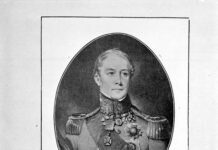There is a long historic truth of land occupation that pre-dates written historical records of the area. Archaeological information indicates that Algonquin people have lived in the Ottawa Valley for at least 8,000 years before the Europeans arrived in North America. There has to be a respectful acknowledgment of this fact before we begin telling our own stories of settlement.
For many years, there was a story going round that the site of the Town of Kemptville was bought from its original owner for a yoke of oxen and a fusil (which was a type of gun). It was a colourful tale, and, as far as I can find out, it came from an account of the history of Kemptville written around 1880. However, colourful tales are not necessarily history, so it is interesting to see what the real facts might be.
Kemptville was first located on lot 27 in the Third Concession of the Township of Oxford-on-Rideau. It was granted to Captain Peter Drummond on December 2, 1802, as part of his allocation of land due to him as a veteran of the American War of Independence. He had been an officer in the Loyal Rangers, Jessup’s Corps, and afterwards commanded a company in the second battalion of the Royal Canadian Volunteers. Drummond’s story is itself quite an exciting and adventurous one, but, in this instance, it is enough to record that he sold lot 27 to John Byce (also spelled Boyce), on September 15, 1819 for the sum of £50. The lot straddled the South Branch and contained 200 acres.
Byce immediately flipped the property, selling the south half to Thomas McCargar for £37.10/- on December 4, 1819, and the north half to Asa Clothier for £75 on the same day. John Byce made a handsome profit of more than £60 on the transactions; a far finer sum than a yoke of oxen and a fusil.
The sales agreements recording these property transfers make interesting reading. John Byce agreed to sell to Asa Clothier the half of the lot from its northern boundary to “the centre of the South Branch of the Rideau River, more or less, then upstream along said Branch to Lot 26”. The agreement was witnessed by Trueman Hurd, but not actually drawn up and signed until March 26, 1824. It is likely that Clothier already lived on the lot, where he built the mill around which the village grew, as he is identified in the sale as being “of the Township of Oxford”, whereas Byce is “of South Gower”.
On September 25, 1826, Thomas McCargar sold his half of the lot to Lyman Clothier for £150, making a sizeable profit on the transaction. The Clothier family gradually sold off small sections of the lot over the succeeding decades as the new village grew in population and influence.
The documents recording those first land transactions in what would become Kemptville are also fascinating for the signatures of the parties and witnesses involved. The Clothiers, of course, were at the centre of settlement, not only of Kemptville, but of Oxford Mills also.
The sales agreements were sworn before Levius Church, Deputy Registrar of the County of Grenville. Church also opened the first store in Kemptville, where O’Heaphy’s pub is today, as well as a pot ashery across the street on the banks of the river. Local farmers would burn out the roots of trees they cleared on their land, and bring their ashes to the store, where they would be bartered for goods. Church would turn the ashes into potash for export.
Thomas McCargar was one of the first settlers in South Gower, and at one time owned substantial property there and in Oxford. His homestead farm became part of the Kemptville Agricultural School in 1917 and still stands in a much modified form on the grounds of the Campus. The McCargars were an important family in what is now North Grenville, and it was a member of that family, Cyrus Hugh McCargar, who first mentioned the yoke of oxen and fusil, along with a few other errors in his account of Kemptville’s early history. More of him another time.
The main witness to both sales in 1819 was Trueman Hurd, another important figure in the early years of Kemptville’s story. According to reliable sources, Hurd, McCargar, Clothier, and David Beech were the first settlers in Kemptville. Trueman Hurd provided land for the Roman Catholic Church in 1834 and his house still stands on the north-east corner of Clothier and Hurd.








